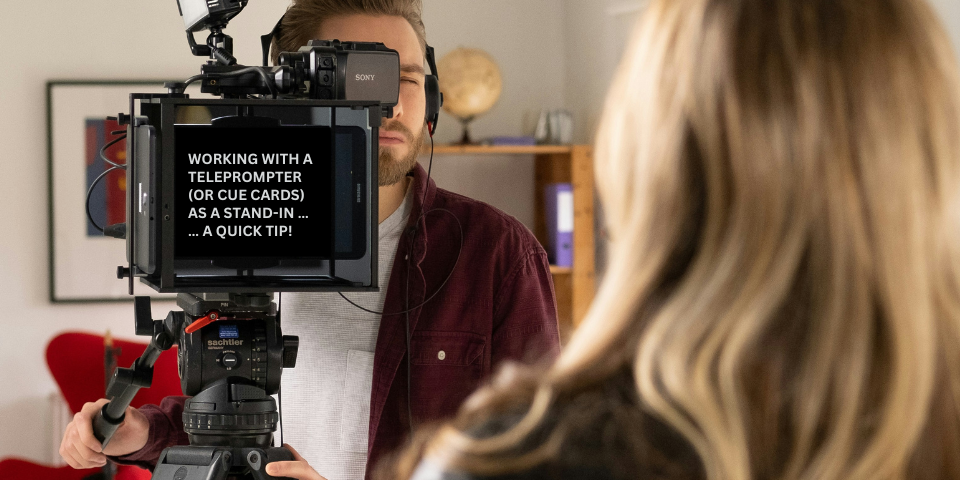As you likely know, when you are working as a stand-in on a television or film set, “marks” are the little pieces of T-shaped tape that denote on the set where your actor stands. It is your responsibility as a stand-in to stand on your mark when you’re asked.
But what do you do if somebody else is standing on your mark? Have no fear because it’s not always a bad thing.
Here are some common scenarios on set when someone else might be on your mark — and whether to do anything about it.
The DP Is on Your Mark
If the director of photography (DP) is on your mark, usually there is nothing to fear. The DP may be trying to direct where to place the camera relative to your actor’s position, or — more likely — may be looking at the position of the lights in case they need to be moved.
Now, if the DP is standing on your mark because you have been called to set and were nowhere to be found, there’s a good chance you would have been useful to the DP in the interim. Simply make your presence known to an AD should you see the DP on your mark, and if it’s appropriate to rotate you in, it will happen.
The Gaffer Is on Your Mark
The gaffer is the head of the electrical department on set, and this person works closely with the DP. The gaffer requests particular lights to be brought to set per the DP’s request in order to light scenes.
Once those lights arrive and are set up, the gaffer may stand on your mark to direct the crew to position the lights in the way that best lights your position. Standing on your mark is helpful for gaining the optimal perspective to position the lights.
The gaffer may even request to stand on your mark when you are in the middle of standing in. If so, oblige. There is little to fear if the gaffer is on your mark. Simply step back onto your mark once the gaffer steps off it.
A Camera Assistant Is on Your Mark
Camera assistants are those who pull the focus but also who lay the marks down. They may need to stand on your mark to set up a shot.
However, usually they can set up the shot with you just as well. If you see a camera assistant on your mark, it may be a sign that it would be useful if you were there rather than not there. Step in once they are done being on your mark — and field out whether stepping in more immediately would be more helpful.
Another Stand-In Is on Your Mark
If you show up to set and another stand-in is on your mark, keep in mind the context before making a final judgment about this scenario.
Particular productions may use a mix of regular stand-ins and irregular stand-ins unfamiliar to the crew. These irregular stand-ins may be pulled from the background actors or may simply be day-playing as stand-ins. They may be experienced, but all too often they are inexperienced or at least don’t have a sense of the rhythms of the particular production.
If you show up to set and one of the regular stand-ins on the production is on your mark, it could mean a number of things. For one, people like the DP may simply call out the name of a regular stand-in to stand on an actor’s mark, even if that actor is not assigned to the regular stand-in. This is much like a carpenter going to a trusty hammer rather than working with a new tool. Or, of course, it could be a sign that you weren’t on set soon enough and production needed to borrow this stand-in while it waited for you.
Should you show up to set and see a regular stand-in on your mark, stay close (perhaps within eyesight) of the regular stand-in, and perhaps ask an AD if you should step in. It may be more trouble than it’s worth to switch out with the regular stand-in, especially if it’s a quick setup. But if it’s not trouble, swap out with the regular stand-in.
However, if instead this is an aggressive move on the part of the stand-in, and if it’s been a repeat issue, raise the issue either with the stand-in or an AD. It may be that the regular stand-in is acting unprofessionally rather than being helpful to the crew.
More likely than not, though, a regular stand-in on your mark is not something to which to take offense. It simply serves a practical purpose in the moment. To circumvent this happening, get to set as soon as “Checking the gate!” is called out and stay close to your actor’s mark.
A PA Is on Your Mark
If you’re nowhere to be found or you’re in the restroom when second team is called to set, a production assistant (PA) may stand on your mark until you arrive. While it might be a dicey practice in terms of union division of labor, as long as it is not the PA’s dedicated job to stand in, it is generally acceptable to have a PA stand in until you arrive on set.
Should you arrive and see a PA standing on your mark, swap out with the PA as soon as you can. Leave any explanations as to where you were for later disclosure. Your job is to stand in, and you need to immediately tune in to the needs of the production at that very moment.
An AD Is on Your Mark
Often, this is a bit more serious. An AD may step on your mark if you’re not on set and wait for you much as a PA would. However, what’s more serious about this is that the AD usually has so much to focus on while setting up a shot, and being tied to a mark while waiting for you can be counterproductive.
If you see an AD on your mark, swap out with the AD as soon as you can.
Ben’s Tip!
After you’ve been excused from set, watch the monitors. If shooting stalls and camera or lights need to be adjusted, you might see on the monitors an AD step onto your mark.If I see this, usually I will rush over to set and make my presence visible to the AD. At this point, if it’s useful for me to stand in, the AD will rotate me in. If it’s a quick adjustment, I might not be rotated in. But usually if I see an AD on my mark, I want to get to set immediately and try to rotate out.
Your Actor Is on Your Mark
While it may be obvious, if your actor is on your mark, step aside and let your actor stand in.
If it’s at an inopportune moment for the actor to be there, hover close to set in case the actor is excused from set and you need to step in.
But occasionally actors are just fine with doing their own stand-in work. If that’s the case, your job simply becomes staying close to set and being available should production need you at a moment’s notice.
Conclusion
Sometimes it just makes sense for another crew member to assume your mark when you are standing in. Feel out whether it is appropriate or something to be nervous about. If it makes you nervous that someone else is on your mark, next time make it to set sooner so that you can assume your mark immediately!
Can you think of other crew members who stand on your marks? Share any you can think of below!






Leave A Comment